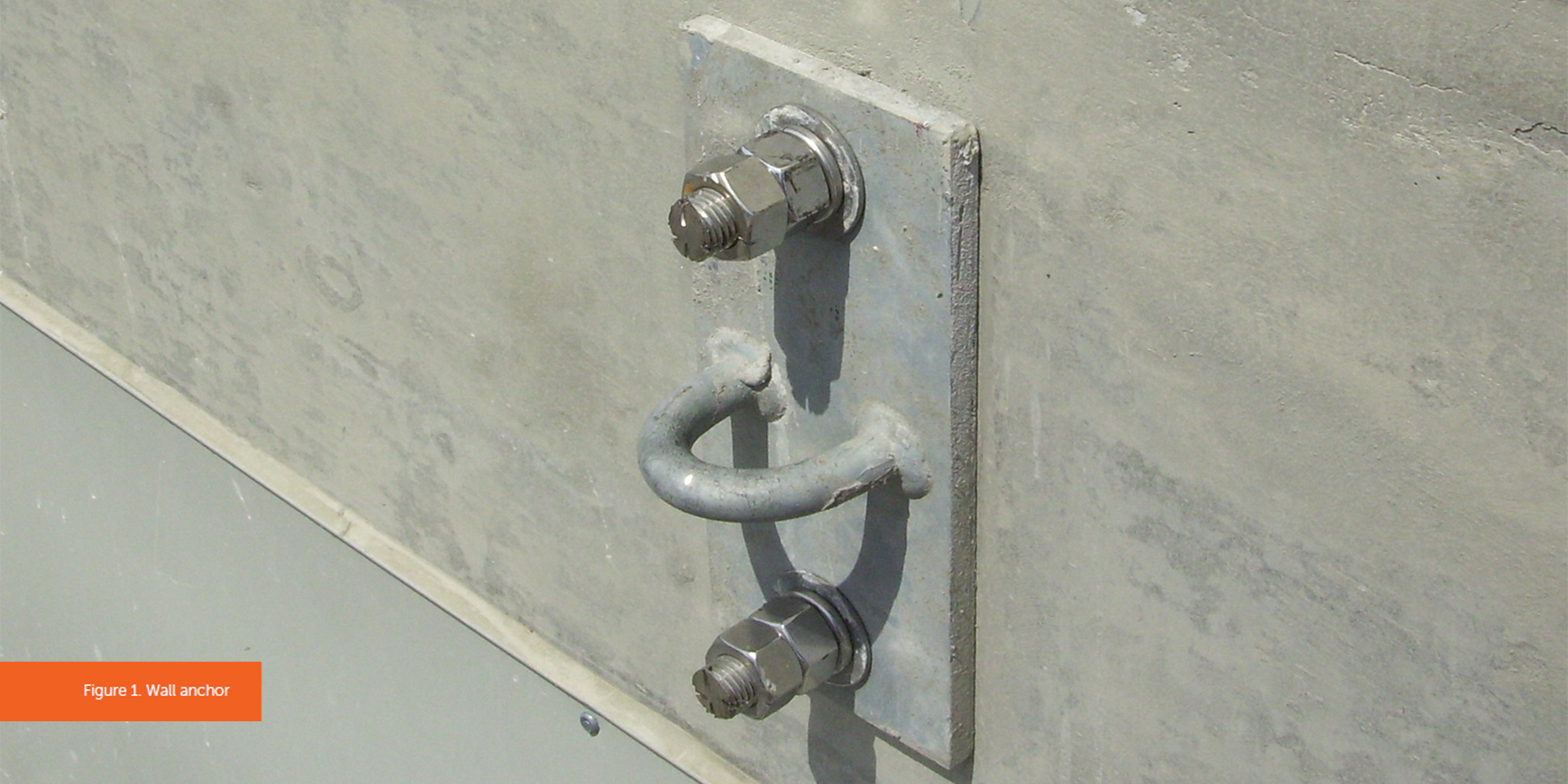
The Permanent Installation (PI) Council continues to receive phone calls asking for equipment and using the wrong name, even after last year’s article “Davits aren’t Davits.” Therefore, the council is continuing its education with this article on the terminology for the equipment used in PIs.
Permanently installed equipment is designed, purchased, installed, and permanently dedicated to a building to provide suspended access to the building’s façade. The system is required to be tested after it is installed by a qualified professional engineer and inspected every 12 months thereafter, also by a qualified professional engineer. Before using this equipment, consult the manufacturer’s manual for proper use. As some PIs are
very complicated, only trained personnel are approved to operate the equipment, and, again, they should consult the manufacturer’s manual before use.
An anchor is a point of attachment which supports the loads from personal fall arrest equipment, transportable rigging/support equipment, etc., and transfers the loads to the building/structure. Wall anchors (Figure
1) are secured to the parapet wall or vertical structure of the building. Roof anchors (Figure 2) are attached to the horizontal structure of the building and come up through the roofing material. Flush anchors (Figure
3) are permanently installed in locations where visible anchors are not desired, such as pool decks or other areas with foot traffic. These anchors are normally hidden under pavers or covers to be out of view. Lastly, horizontal lifeline anchors (Figure 4) are installed in areas where railings are not present and a fall prevention system is required.
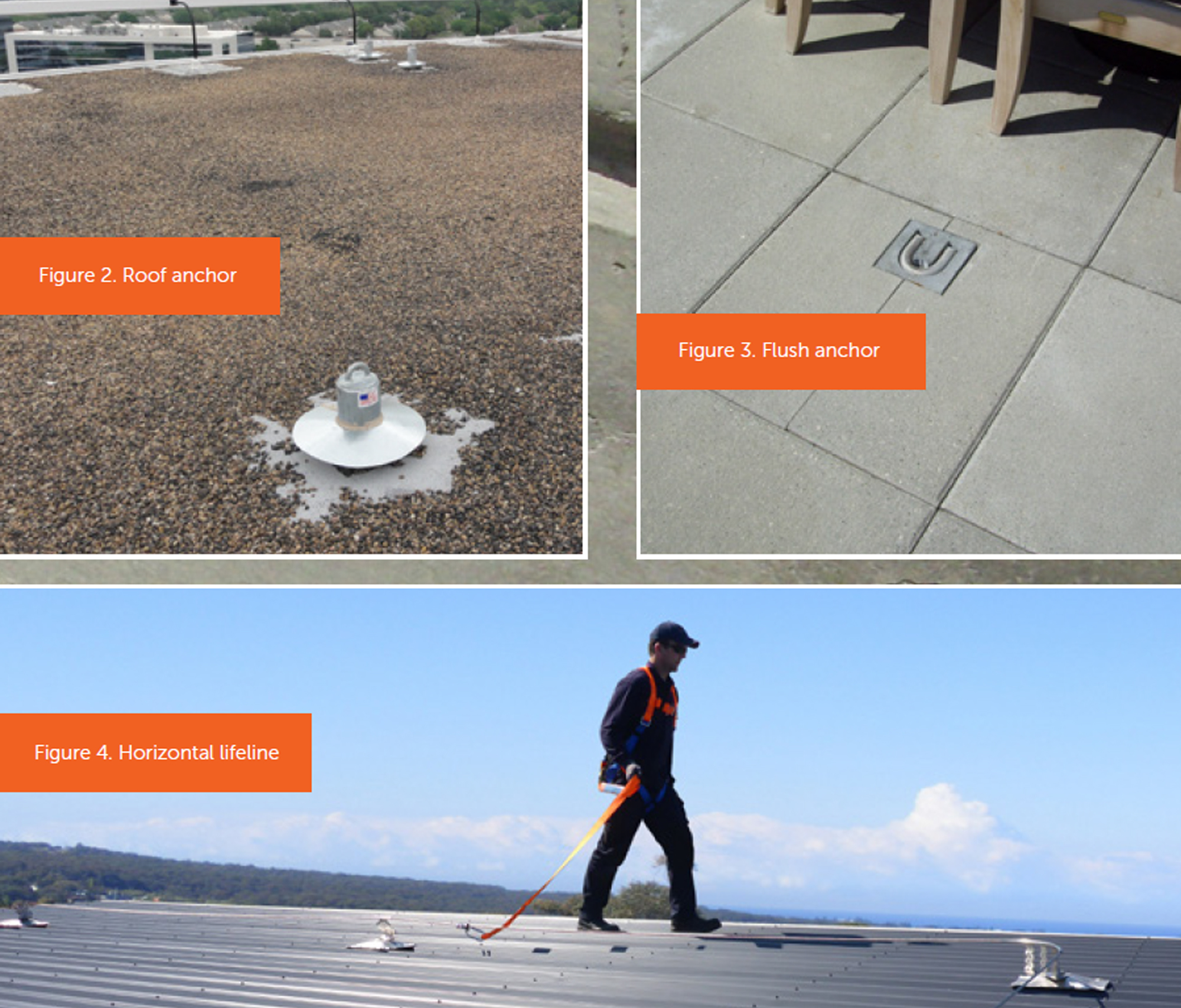
A davit is a piece of equipment used for supporting temporarily or permanently suspended access equipment or material. Davits can be broken down into two categories, ground-rigged and roof-rigged (Figures 5 and 6).
A ground-rigged davit is used when the suspended platform is launched from the ground and does not go above the building face or parapet. A roof-rigged davit is used when the platform is launched from the roof, goes above the parapet, and rotates out to descend along the outside face of the building. Ground- and roof-rigged davits have two types of subcategories, bottom- or top-rotating. This is easily identified by where they rotate. Unlike outrigger beam setups, a davit has a single, permanently installed attachment point into the structure which supports its operating moment load called a pedestal (Figures 7 and 8) or socket. For more information about davits, pedestals, and sockets, please see the article in the SA Magazine November/December 2020 issue.

A davit carriage (Figure 9) connects a davit, or davits, to a track secured to the building that closely follows the contour of the façade. The davit carriage is either powered or manually pushed along the track. Compared to standard davits that have to be moved from pedestal to pedestal, having everything together and travelling on tracks reduces the amount of time it takes to transport the davits from one location to another. Davit carriages may be used for supporting temporary or permanent powered platforms or for lifting materials.
Ladders and travelling gantries are permanently installed equipment on buildings with sloped roofs, specifically for interior and exterior atriums where access is difficult (Figure 10). They are supported or suspended from tracks that follow the façade of the building and are driven manually or via power.

A monorail is a railway permanently installed to the buildings structure (Figures 11 and 12). Monorails closely follow the façade; therefore, they are an ideal solution for suspended access when recessed or overhanging facades, sloped roofs, cantilevered eyebrows, and inside atriums are present. All monorails are designed to be used with a powered or manual trolley system, to allow the platform or work cage to roll along the monorail to the desired location.

An outrigger is a beam or tube that is projected beyond the building’s façade and used to raise and lower temporarily or permanently suspended access equipment or material. Outriggers are traditionally transportable so that they can be moved from one location to another on the building and are secured to stands or anchors permanently installed into the building.
The suspension rope is typically attached to the FRONT of an outrigger beam (Figure 13). However, backfed outriggers (Figure 14) allow the suspension rope to be secured to the REAR portion of the beam and the tip of the rope is fed through the beam and down to the ground. Pushthru outriggers (Figure 15) slide through stands in the wall of the building and project beyond the building’s façade. Once in position, the suspension rope is secured to the REAR portion of the outrigger and the tip of the rope is fed through the tube to the ground. Backfed and push-thru Outriggers allow for easier and safer wire rope installation and removal.

Suspended platforms have many names, however, there are three different types of suspended scaffolding platforms. Temporary transportable suspended platforms – platforms that have a hoist or hoists located on the platform and are not dedicated to a building, as they are usually rented – are NOT considered a PI (Figure 16).
A permanent-installed platform, also known as powered platform, is easy to differentiate from the temporary platform as the permanent platform will have metal mesh all around the platform. However, the difficult portion is seeing the difference between permanent platforms. Some are self-powered, meaning that the hoist(s) is located on the platform itself (Figure 17).
Other permanent platforms are roof powered, meaning that the hoist(s) is located on the rigging equipment, NOT the platform (Figure 18 on the next page). Factors such as the rigging, height of building, etc., dictate which type of permanent platform is required.
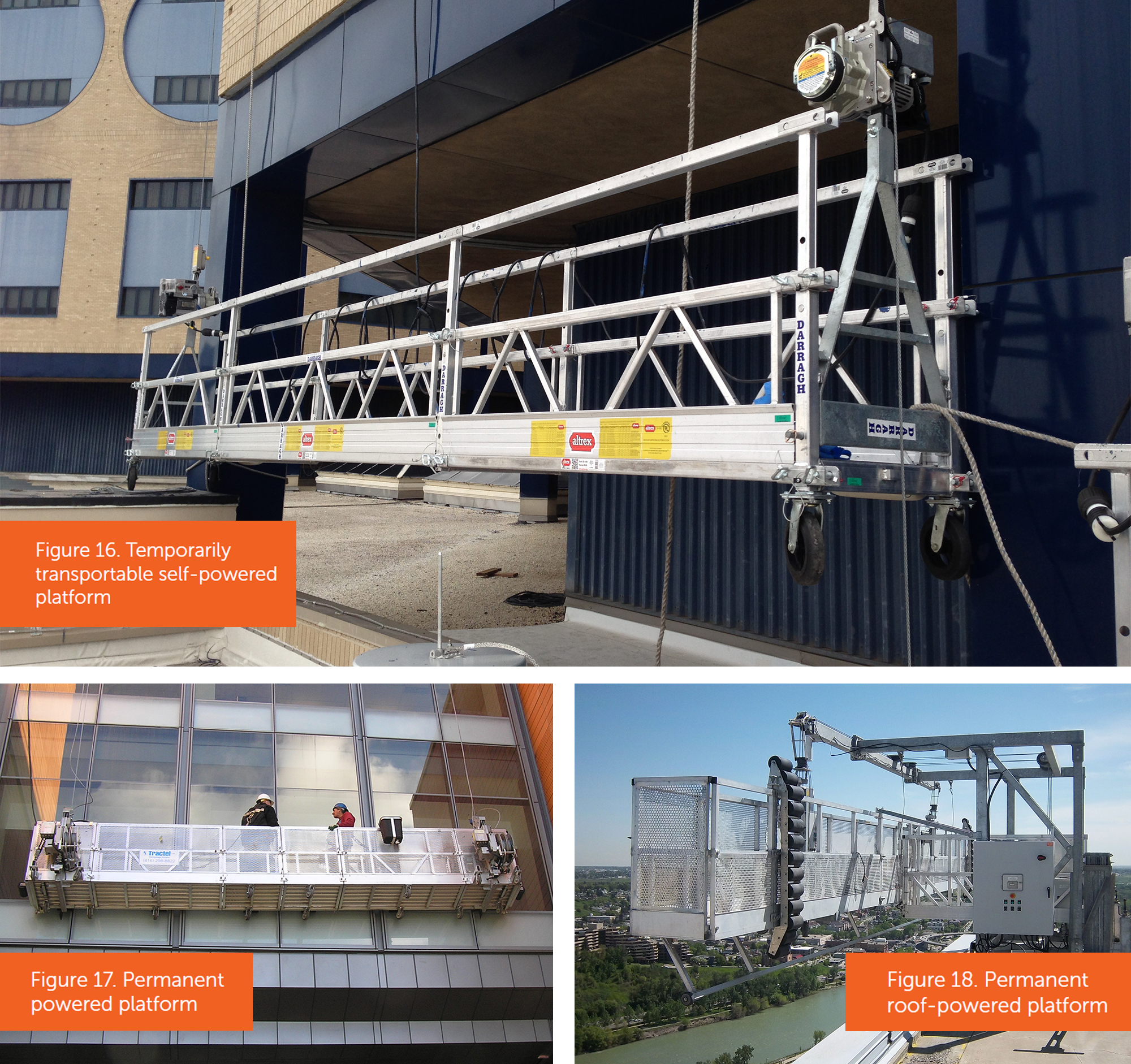
A rigging sleeve, known as a pigeonhole, is a tube permanently secured onto the roof of a building to allow the suspension cable to pass through and provide suspended access to a recessed portion of the building (Figure 19).

A roof car (Figure 20) is a machine on the roof used for window washing and exterior building maintenance that can be fixed in place, track mounted, or moved on a concrete runway. It may have a telescoping boom, telescoping mast, luffing boom. or other features. The suspended equipment may be a temporary self-powered platform, a permanent self-powered platform, or a permanent roof-powered platform. A building maintenance unit (BMU) is a roof car with a roof-powered platform (Figure 21). This system can eliminate the need for support equipment, such as davits or outriggers, on lower roofs or balconies.
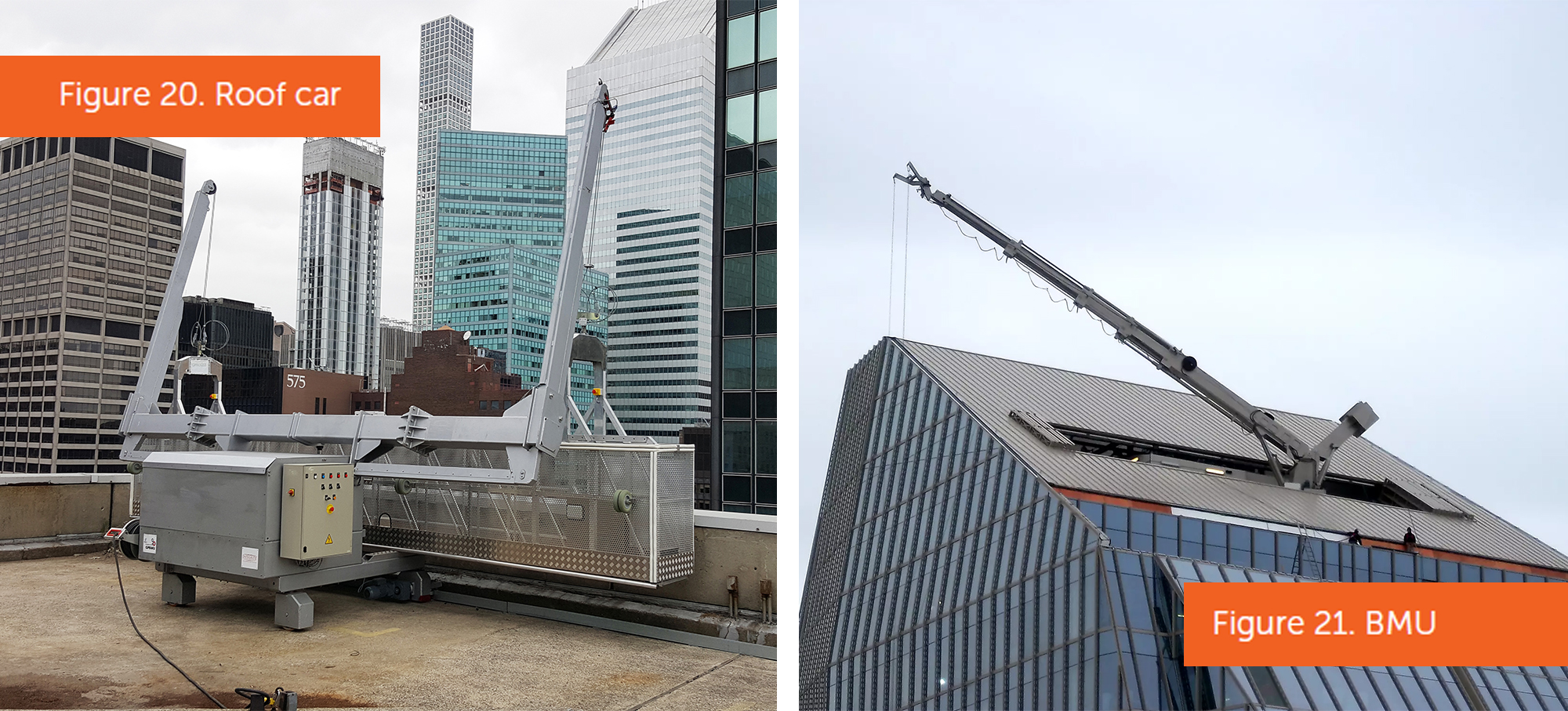
Tie-in guides secure the suspended equipment against the building façade to help prevent the equipment from damaging the façade in the event of high winds. One method of tying in the platform is using intermittent stabilization anchors (ISAs). These anchors (Figures 22a and 22b) are permanently installed into the structure approximately every 30 to 50 feet vertically. “Pins” including a stabilizer tie, or lanyard, are then inserted between each ISA and the suspension rope(s) as the suspended platform is descending to stabilize the platform. When ascending the platform, the user simply removes the pin from the ISA and wire rope(s) and continues traveling. Note that this technique can only be used when roof-launching the platform.
Another method of tying in the platform is using a mullion track (Figure 23). This system keeps the equipment in continuous contact with the building as the platform is attached to a track roller bracket that rolls along a vertical track permanently installed into the building.
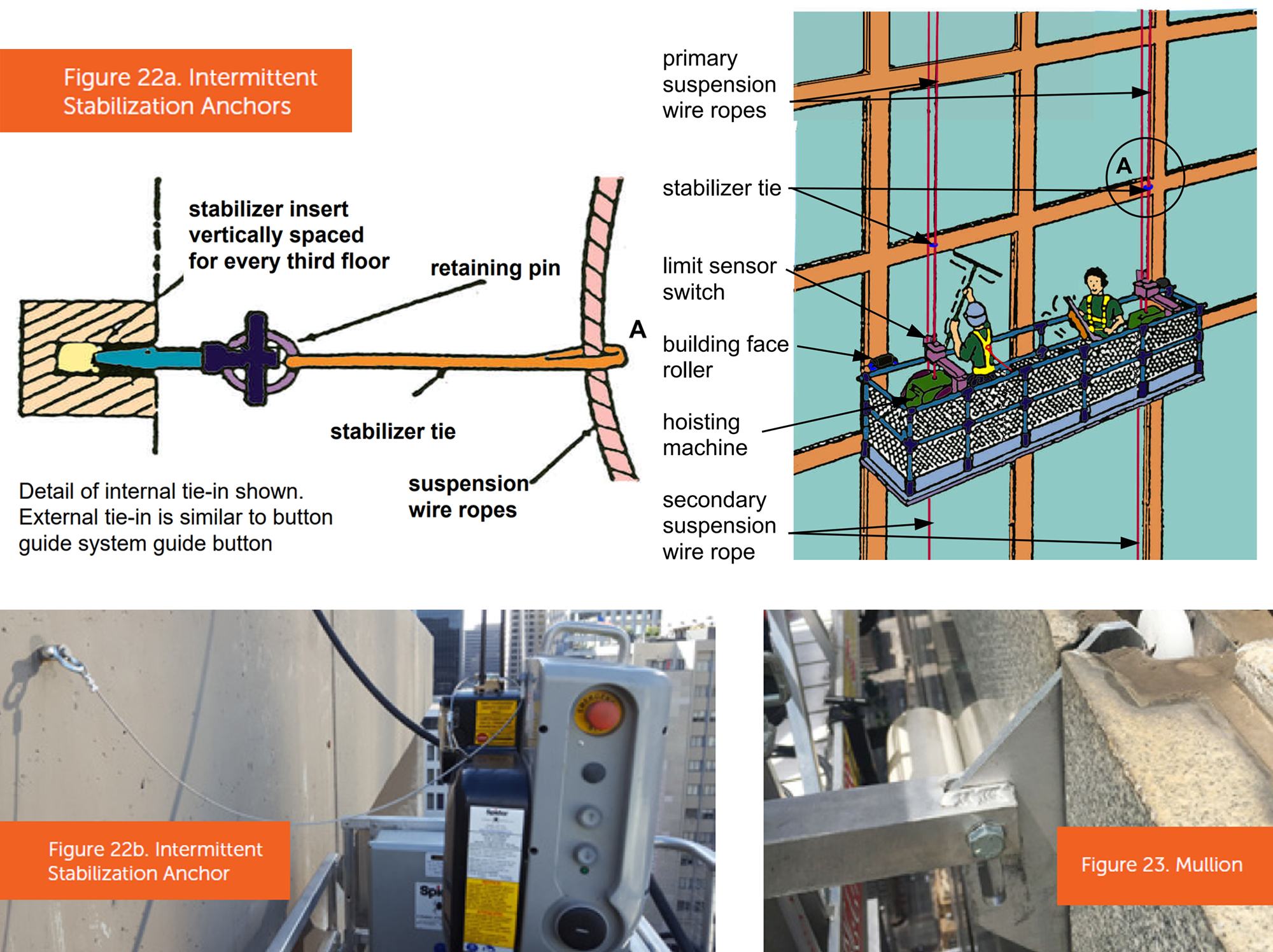
About the Authors
Brian Andrews is the VP Engineering at Bee Access and Chair of the Scaffold & Access Industry Association (SAIA) Permanent Installation Council. Contact him at brian@beeaccess.com
Lucas Oliver is the Regional Sales Manager at Tractel and co-chair of the PI Council.
Download PDF